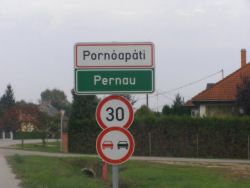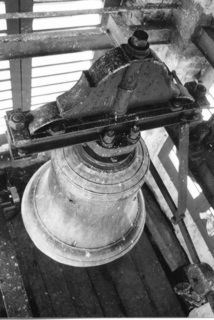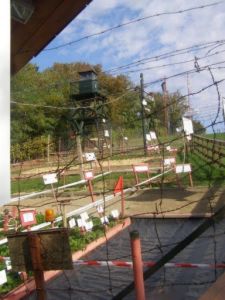|
 The village of Pernau, located on the other side of the border from Burgenland’s
Bildein, Höll and Deutsch-Schützen, received its name from a monastery that
was established there in the 12th century. The word “–apáti” – “–abbey”
in Pornóapáti leaves no doubt as to the name’s origin. The Cistercian monks
fled from the marauding Turks in 1530 and never returned; the buildings that
housed the monks have disappeared long ago. However, a bell that used to summon
the monks and the faithful to prayer now does its time-honored duty from the
belfry of Pernau’s village church that was built in 1795. That bell is now
Hungary’s oldest functioning bell. It was cast in 1464, twenty-eight years
before Christopher Columbus arrived on the shores of America.
The village of Pernau, located on the other side of the border from Burgenland’s
Bildein, Höll and Deutsch-Schützen, received its name from a monastery that
was established there in the 12th century. The word “–apáti” – “–abbey”
in Pornóapáti leaves no doubt as to the name’s origin. The Cistercian monks
fled from the marauding Turks in 1530 and never returned; the buildings that
housed the monks have disappeared long ago. However, a bell that used to summon
the monks and the faithful to prayer now does its time-honored duty from the
belfry of Pernau’s village church that was built in 1795. That bell is now
Hungary’s oldest functioning bell. It was cast in 1464, twenty-eight years
before Christopher Columbus arrived on the shores of America.
 In the course of centuries and bloody central European history, records have
been lost so not everything about Pernau’s past is well established. It is
known that present day Pernau was founded in 1691 by German speaking people.
However, where exactly they came from is less certain. Research points to the
tri-corner area where Bohemia, Bavaria and Austria meet. They settled in the
fertile valley of the Pinka river, established a thriving, Catholic village,
farmed their fields, maintained their culture and language, and with their
Hungarian, Croatian and German-speaking neighbors formed a microcosm of the
multi-ethnic patchwork that characterized the Austro-Hungarian Empire. Sadly,
the tranquility of this rural life succumbed to the tragedies and upheavals of
the 20th century: the dismemberment of the Austro-Hungarian Empire, the new
border mandated by the Treaty of Trianon, the rift caused by the Volksbund and
the deportation of its members in 1946, the separation and total isolation of
the village from its neighbors by the Iron Curtain, the escape of many after the
revolution of 1956, and Hungary’s willful suppression of its ethnic minorities
until 1989.
In the course of centuries and bloody central European history, records have
been lost so not everything about Pernau’s past is well established. It is
known that present day Pernau was founded in 1691 by German speaking people.
However, where exactly they came from is less certain. Research points to the
tri-corner area where Bohemia, Bavaria and Austria meet. They settled in the
fertile valley of the Pinka river, established a thriving, Catholic village,
farmed their fields, maintained their culture and language, and with their
Hungarian, Croatian and German-speaking neighbors formed a microcosm of the
multi-ethnic patchwork that characterized the Austro-Hungarian Empire. Sadly,
the tranquility of this rural life succumbed to the tragedies and upheavals of
the 20th century: the dismemberment of the Austro-Hungarian Empire, the new
border mandated by the Treaty of Trianon, the rift caused by the Volksbund and
the deportation of its members in 1946, the separation and total isolation of
the village from its neighbors by the Iron Curtain, the escape of many after the
revolution of 1956, and Hungary’s willful suppression of its ethnic minorities
until 1989.
 Between January and March of 1923, ten villages in the lower Pinka valley,
originally assigned to Austria, returned to Hungary. Pernau was among them. The
process by which that return occurred remains cloudy and mired in controversy.
To this day, Hungary celebrates the ten villages as “hüséges falvak” –
“faithful villages;” Austria mourns their loss by referring to them as “verlorene
Dörfer” – “lost villages.” In a nutshell, the plebiscite that was to
decide the repatriation of these villages often did not include all residents.
Large estate owners such as the Bavarian royalty and the local Erdödy family
exerted undue influence over the decision for their own interests. Agitation,
intimidation and even the murder of influential people like Father Pataki of
Pernau in 1921 had their desired effect on the outcome.
Between January and March of 1923, ten villages in the lower Pinka valley,
originally assigned to Austria, returned to Hungary. Pernau was among them. The
process by which that return occurred remains cloudy and mired in controversy.
To this day, Hungary celebrates the ten villages as “hüséges falvak” –
“faithful villages;” Austria mourns their loss by referring to them as “verlorene
Dörfer” – “lost villages.” In a nutshell, the plebiscite that was to
decide the repatriation of these villages often did not include all residents.
Large estate owners such as the Bavarian royalty and the local Erdödy family
exerted undue influence over the decision for their own interests. Agitation,
intimidation and even the murder of influential people like Father Pataki of
Pernau in 1921 had their desired effect on the outcome.
Even with the new border of 1923, village life in Pernau continued in its
time-honored groove until the late 1930’s when the agitation of the Volksbund
divided the German-speaking majority. Starting with the deportation of more than
a hundred ethnic Germans to Bavaria in 1946, the village began to change.
Hungarian settlers were brought in to take possession of the houses and
properties of the deported; two years later, Czech-Hungarian settlers were
brought in to dispossess more old-time villagers of their homes and fields. The
diminished ethnic German majority quickly learned to accept the new arrivals and
together the village braced for the next, much more serious onslaught to its
identity, an inimical communist government that came to power in 1948.
 For the next forty years, Pernau became separated from its Austrian neighbors
by a minefield and from its Hungarian neighbors by an electric fence east of the
village. The communists introduced terrible agrarian policies such as forced
collectivization, excessive delivery quotas and a counterproductive tax system.
By the early 1950’s, Pernau that used to produce a surplus of food supplies,
moved to the brink of starvation. The independent farms disappeared. With the
loss of an additional 100 people after the failed revolution of 1956 and the
exodus of the young people from their isolated village, Pernau’s population of
632 in 1941 had dwindled to about 380 by 2000. The cultures of Hungary’s
ethnic minorities were systematically suppressed. German was not taught in
schools. The children of ethnic Germans were kept from attending secondary
schools and universities. Pernau also lost its position as administrative center
of the region, its school, its doctor, pharmacist and priest.
For the next forty years, Pernau became separated from its Austrian neighbors
by a minefield and from its Hungarian neighbors by an electric fence east of the
village. The communists introduced terrible agrarian policies such as forced
collectivization, excessive delivery quotas and a counterproductive tax system.
By the early 1950’s, Pernau that used to produce a surplus of food supplies,
moved to the brink of starvation. The independent farms disappeared. With the
loss of an additional 100 people after the failed revolution of 1956 and the
exodus of the young people from their isolated village, Pernau’s population of
632 in 1941 had dwindled to about 380 by 2000. The cultures of Hungary’s
ethnic minorities were systematically suppressed. German was not taught in
schools. The children of ethnic Germans were kept from attending secondary
schools and universities. Pernau also lost its position as administrative center
of the region, its school, its doctor, pharmacist and priest.
By 1989 when the Iron Curtain came down and the communist system collapsed, the
people didn’t want their land back because they had lost the means and desire
to cultivate it. Farming, which had sustained Pernau’s village life for
centuries, was gone. Today, no one still owns horses or cows or any other farm
animals. Old wagons, plows, harrows and pitchforks rust and rot in decaying
barns. People find work outside of the village, many of them returning only on
weekends to a peaceful and sleepy bedroom community. The streets are normally
deserted because children as well as adults prefer the privacy of their yards,
their homes and the virtual world on TV. The lively social interaction of the
old days has largely disappeared.
 Four decades of socialism unalterably changed Pernau but today the village is
slowly creating a new identity for itself, especially since the opening of the
border in 2007. Knowledge of the German language, a definite liability after
WWII, has become a major asset to the people of Pernau and the other ethnic
German village in the area, Großdorf. Because they can communicate with their
Austrian neighbors, those who want to can easily find work there – a very
significant advantage in today’s depressed economy over compatriots who speak
only Hungarian. Some beautiful new homes in Pernau and Großdorf testify to this
development. Today there is increased human traffic from Burgenland. Many
Austrians come on foot or by bike to enjoy the cuisine, the wine, the reasonable
prices, the unspoiled countryside, and the hospitality of their Hungarian
neighbors. Young Austrians mob the local tavern on a daily basis. There is a
lively exchange of activities between Pernau and especially Bildein. The two
neighboring villages celebrate their Kirchtage and other festivities together.
Burgenländer enjoy the option of shopping in Stein am Anger; those of Pernau,
who can afford it, relish a shopping trip to Oberwart.
Four decades of socialism unalterably changed Pernau but today the village is
slowly creating a new identity for itself, especially since the opening of the
border in 2007. Knowledge of the German language, a definite liability after
WWII, has become a major asset to the people of Pernau and the other ethnic
German village in the area, Großdorf. Because they can communicate with their
Austrian neighbors, those who want to can easily find work there – a very
significant advantage in today’s depressed economy over compatriots who speak
only Hungarian. Some beautiful new homes in Pernau and Großdorf testify to this
development. Today there is increased human traffic from Burgenland. Many
Austrians come on foot or by bike to enjoy the cuisine, the wine, the reasonable
prices, the unspoiled countryside, and the hospitality of their Hungarian
neighbors. Young Austrians mob the local tavern on a daily basis. There is a
lively exchange of activities between Pernau and especially Bildein. The two
neighboring villages celebrate their Kirchtage and other festivities together.
Burgenländer enjoy the option of shopping in Stein am Anger; those of Pernau,
who can afford it, relish a shopping trip to Oberwart.
 About half of the village population still claims German roots. Older folks
especially are trying hard to recapture what they can of their German cultural
heritage and transmit it to their less interested children. In the absence of
any help from the government, the villagers do what they can on their own
initiative. Children are now encouraged to learn German in schools. Pernau’s
Frauenchor that has made a CD with its rendition of old German songs – some in
authentic Hianzisch – are now welcome performers at home and in neighboring
Austria. Efforts by the local women to have Mass said in German has paid off;
now on the 1st and 3rd Sunday, Mass is said in German, drawing worshipers also
from nearby Austrian villages. In recent years, Pernau’s residents also
participate in yearly Heimat-Treffen gatherings for German-speaking communities.
There is a concerted effort to bring back old community customs. For example,
although there are no individually cultivated cornfields in Pernau any more,
someone recently brought in a big load of corn just so that the locals could
have an old-fashioned, communal corn-shucking event, locally called “kukoricafosztás”
or “Kugritzohzuiha” in Hianzisch.
About half of the village population still claims German roots. Older folks
especially are trying hard to recapture what they can of their German cultural
heritage and transmit it to their less interested children. In the absence of
any help from the government, the villagers do what they can on their own
initiative. Children are now encouraged to learn German in schools. Pernau’s
Frauenchor that has made a CD with its rendition of old German songs – some in
authentic Hianzisch – are now welcome performers at home and in neighboring
Austria. Efforts by the local women to have Mass said in German has paid off;
now on the 1st and 3rd Sunday, Mass is said in German, drawing worshipers also
from nearby Austrian villages. In recent years, Pernau’s residents also
participate in yearly Heimat-Treffen gatherings for German-speaking communities.
There is a concerted effort to bring back old community customs. For example,
although there are no individually cultivated cornfields in Pernau any more,
someone recently brought in a big load of corn just so that the locals could
have an old-fashioned, communal corn-shucking event, locally called “kukoricafosztás”
or “Kugritzohzuiha” in Hianzisch.
Looking toward the future, Pernau’s economic and cultural renaissance will
come about to a large extent thanks of its proximity to Austria. Through their
employment opportunities there, many in Pernau bring home decent wages, a new
perspective for a better life and an awareness of the cultural heritage they
share with their neighbors in Burgenland.
|